VIENTIANE
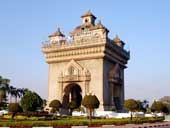 Vientiane the capitals city of Laos is perhaps one of Southeast Asia’s most unique capitals. A quiet and laidback city, there are plenty of interesting French colonial buildings, temples and lively markets located alongside rice fields. Vientiane the capitals city of Laos is perhaps one of Southeast Asia’s most unique capitals. A quiet and laidback city, there are plenty of interesting French colonial buildings, temples and lively markets located alongside rice fields.
Laos is the highlight of their Southeast Asia trip as it has been saved from the mass tourist trail that has led to her neighbors –Thailand ,Vietnam and Cambodia. This relatively undeveloped nation is located between rugged mountains and the fertile low lands of the Mekong, and is touched by both European and Asian cultures. The city’s man-made structures are as distinctive as the areas of natural splendor. Modernity has yet to infiltrate this sleepy capital, where temples and religious affiliations blend with the rural foundations of the city. The majority of the city's sights are situated within relatively close proximity of each another due to the fact that an urban sprawl has yet to materialize within the city.
PHA THAT LUANG
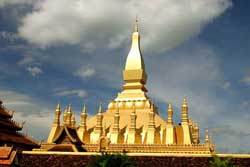 The most important monument in Laos, the Pha That Luang (Great Sacred Stupa) is also found here. Some other interesting places in this city include Wat Pha Kaew, a former royal temple converted into a museum and Wat Si Saket, the city’s oldest temple. Xieng Khuan is 24 kilometers (15 miles) south of Vientiane where an amazing collection of Buddhist and Hindu sculptures can be found in a meadow. Luang Prabang is the oldest town still in existence in Laos. The most important monument in Laos, the Pha That Luang (Great Sacred Stupa) is also found here. Some other interesting places in this city include Wat Pha Kaew, a former royal temple converted into a museum and Wat Si Saket, the city’s oldest temple. Xieng Khuan is 24 kilometers (15 miles) south of Vientiane where an amazing collection of Buddhist and Hindu sculptures can be found in a meadow. Luang Prabang is the oldest town still in existence in Laos.
WAT SISAKET
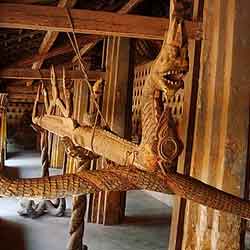 The only temple in Vientiane to survive the sacking of the city by the Siamese in 1828, Wat Sisaket is the oldest and considered by many to be the most interesting of the Laotian temples. The interior walls of Ho Trai and the main hall feature hundreds of little niches and shelves containing a total of 6,840 Buddha images and Buddhist inscriptions from the 18th century. Over 300 hundred Buddha images varying in size and material reside on the shelves, amongst the silver and ceramic Buddhist images, most of which are from 16th -19th century Vientiane. The only temple in Vientiane to survive the sacking of the city by the Siamese in 1828, Wat Sisaket is the oldest and considered by many to be the most interesting of the Laotian temples. The interior walls of Ho Trai and the main hall feature hundreds of little niches and shelves containing a total of 6,840 Buddha images and Buddhist inscriptions from the 18th century. Over 300 hundred Buddha images varying in size and material reside on the shelves, amongst the silver and ceramic Buddhist images, most of which are from 16th -19th century Vientiane.
WAT HO PHAKEO
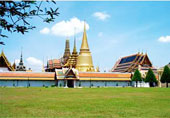 This temple was built in 1565 as a royal chapel and repository for the celebrated statue of the Emerald Buddha, which the Laotians had seized from Northern Thailand in 1551. The statue remained in the temple until 1778, when the Thais invaded and recaptured it, taking it to Bangkok. The temple was destroyed in 1828-1829 during the Thai sacking of Vientiane; rebuilt in 1936; and restored again in 1993. Inspired by a 19th century Bangkok temple style, it is renowned throughout Southeast Asia for its intrinsic value to Buddhist art. This temple was built in 1565 as a royal chapel and repository for the celebrated statue of the Emerald Buddha, which the Laotians had seized from Northern Thailand in 1551. The statue remained in the temple until 1778, when the Thais invaded and recaptured it, taking it to Bangkok. The temple was destroyed in 1828-1829 during the Thai sacking of Vientiane; rebuilt in 1936; and restored again in 1993. Inspired by a 19th century Bangkok temple style, it is renowned throughout Southeast Asia for its intrinsic value to Buddhist art.
PATUXAI
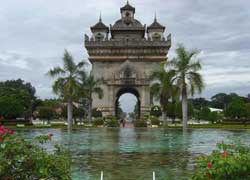 Patuxai (literally Victory Gate or Gate of Triumph), formerly the Anousavary or Anousavari Monument, is situated in the centre of Vientiane. Built between 1962 and 1968, the Laotians built it as a mark of respect for all those who fought in the struggle for independence from the French. Patuxai (literally Victory Gate or Gate of Triumph), formerly the Anousavary or Anousavari Monument, is situated in the centre of Vientiane. Built between 1962 and 1968, the Laotians built it as a mark of respect for all those who fought in the struggle for independence from the French.
Ironically, the monument bears a slight resemblance to the Arc de Triomphe, although the attention to detail and intricate design is typically Laotian, boasting four rather than two archways. The view from the top is spectacular. Built with cement that was purchased from America, with the intention of constructing a new airport, the locals sometimes refer to the monument as the 'vertical runway'.
THAT DAM
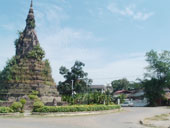 Known as the ‘Black Stupa', many locals believe this mythological structure was once inhabited by a seven-headed dragon (now dormant) that stood to protect the city from the threat of the Siamese. Another tale that does the rounds says that the gold that once graced the surface was taken when the Siamese army ransacked Vientiane back in 1828. Situated in the centre of the city, just past the US embassy, you will find one of Laos' oldest temples. Known as the ‘Black Stupa', many locals believe this mythological structure was once inhabited by a seven-headed dragon (now dormant) that stood to protect the city from the threat of the Siamese. Another tale that does the rounds says that the gold that once graced the surface was taken when the Siamese army ransacked Vientiane back in 1828. Situated in the centre of the city, just past the US embassy, you will find one of Laos' oldest temples.
BUDDHA PAKR(XIENG KHUAN)
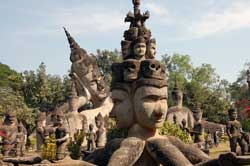 24km south of Vientiane, Buddha Park is in a field near the Mekong River. The park, as its name would suggest, is littered with religious sculptures and was built in 1958 by the philosopher Bunleua Sulilat who famously combined Buddhist and Hindu philosophy, mythology and iconography. 24km south of Vientiane, Buddha Park is in a field near the Mekong River. The park, as its name would suggest, is littered with religious sculptures and was built in 1958 by the philosopher Bunleua Sulilat who famously combined Buddhist and Hindu philosophy, mythology and iconography.
The featured gods range from Vishnu to Arjuna and many in between, all allegedly crafted by unskilled artists who followed the explicit directions of Sulilat. The pumpkin-shaped monument has three levels, each representing heaven, hell and earth.
Beyond these the roof area has a superb panoramic view of the surrounding park and river.
BAN HOM
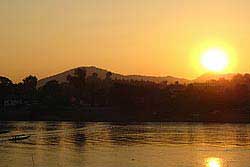 Just 16 kilometers outside of Vientiane situated on the banks of the Mekong is the agricultural city of Ban Hom. A day trip might involve taking a wander around the preserved temples before visiting a primary school or watching a weaving demonstration, where the process of fabric making is laid bare. This day is really about getting to grips with authentic Laos culture, with everything from school presentations to observing traditional farming and fishing methods on the itinerary. Just 16 kilometers outside of Vientiane situated on the banks of the Mekong is the agricultural city of Ban Hom. A day trip might involve taking a wander around the preserved temples before visiting a primary school or watching a weaving demonstration, where the process of fabric making is laid bare. This day is really about getting to grips with authentic Laos culture, with everything from school presentations to observing traditional farming and fishing methods on the itinerary.
LAOS NATION CULTURE HALL
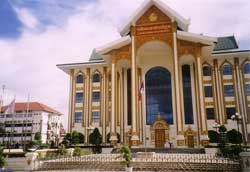 Built by the Chinese in the 1990’s, as a gift to the Laos people, the building is not the most attractive Vientiane has known. Occasionally French cinema and Lao classical dance events are held here within the hall, although it is difficult to access information to find out exactly when. Those interested should keep an eye on the Vientiane Times. Built by the Chinese in the 1990’s, as a gift to the Laos people, the building is not the most attractive Vientiane has known. Occasionally French cinema and Lao classical dance events are held here within the hall, although it is difficult to access information to find out exactly when. Those interested should keep an eye on the Vientiane Times.
LAOS NATIONAL MUSEUM
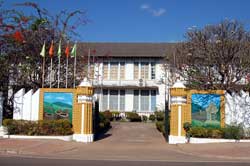 This French colonial building, formerly a government office block, is now used to document the struggles and the eventual overthrowing of the French and the subsequent implementation of the communist structure. The Museum Revolution is a two-storey colonial mansion, separated into different sections; each relevant to the country's history. Departments include culture, archaeology, history and politics, with the latter two making up the majority of the display. This is an interesting way to get better acquainted with the history of Laos through the eyes of the country and visitors should keep in mind that the English translations are not that detailed but the photographs and displays are well put together and insightful all the same. This French colonial building, formerly a government office block, is now used to document the struggles and the eventual overthrowing of the French and the subsequent implementation of the communist structure. The Museum Revolution is a two-storey colonial mansion, separated into different sections; each relevant to the country's history. Departments include culture, archaeology, history and politics, with the latter two making up the majority of the display. This is an interesting way to get better acquainted with the history of Laos through the eyes of the country and visitors should keep in mind that the English translations are not that detailed but the photographs and displays are well put together and insightful all the same.
LUANG PRABANG
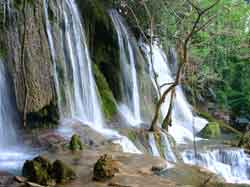 The capital of Lane Xang, the first Laos kingdom during the reign of Far Ngum. Situated at the confluence of the Mekong and the Nam Khan Rivers, Luang Prabang is a charming little town. Wat Xieng Thong is one of the finest pagodas in Luang Prabang. Built in 1559 by King Setthathirat, it represents the most typical example of the Luang Prabang style. The National Museum (former Royal Palace) contains a collection of 15th to 17th century Buddhist statues including the famous Golden Buddha and the a rare Khmer bronze drum. This small wooden palace was built in the early 20th century by the French in Khmer Style. The capital of Lane Xang, the first Laos kingdom during the reign of Far Ngum. Situated at the confluence of the Mekong and the Nam Khan Rivers, Luang Prabang is a charming little town. Wat Xieng Thong is one of the finest pagodas in Luang Prabang. Built in 1559 by King Setthathirat, it represents the most typical example of the Luang Prabang style. The National Museum (former Royal Palace) contains a collection of 15th to 17th century Buddhist statues including the famous Golden Buddha and the a rare Khmer bronze drum. This small wooden palace was built in the early 20th century by the French in Khmer Style.
XIENG KHUANG
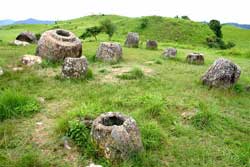 Xieng Khuang is a high green mountainous province offering a beneficial climate but a decidedly unhealthy environment, with large quantities of UXO [unexploded ordnance, aka bombs or bomblets] still lying around in the undergrowth - solid proof of allegations that the CIA and US Air Force conspired in a secret war against the North Vietnamese and Pathet Lao forces in the late 60's, using saturation bombing as their main tool of attack. In the process the USAF totally obliterated many towns and villages, forcing survivors to live in the area's caves. Xieng Khuang is a high green mountainous province offering a beneficial climate but a decidedly unhealthy environment, with large quantities of UXO [unexploded ordnance, aka bombs or bomblets] still lying around in the undergrowth - solid proof of allegations that the CIA and US Air Force conspired in a secret war against the North Vietnamese and Pathet Lao forces in the late 60's, using saturation bombing as their main tool of attack. In the process the USAF totally obliterated many towns and villages, forcing survivors to live in the area's caves.
PAKSE CHAMPASSAK
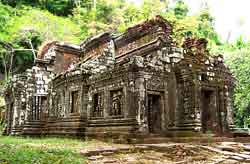 A province to the south where Wat Phu, a temple built in Khmer Architecture is found. Wat Phu is believed to be at least four centuries older than the Angkor Wat of Cambodia. A province to the south where Wat Phu, a temple built in Khmer Architecture is found. Wat Phu is believed to be at least four centuries older than the Angkor Wat of Cambodia.
Khong Island where the rare fresh water dolphins can be seen, and the Phabeng waterfalls which is probably the wildest waterfalls in the world.
VANG VIENG
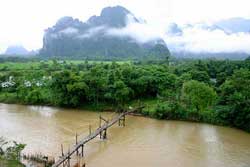 Vang Vieng - halfway between Vientiane and Luang Prabang - is a town almost totally geared up to the lowest common denominator of back packers and is consequently despised by aficionados of real, tranquil, rural Laos. Rowdy bars line up along the main street, each showing a different episode of 'Friends', often simultaneously and without earshot of the others, while young travelers stagger back to neo-monstrosity concrete guest houses after way too many beers.However, it is still possible to avoid the curse of modernism and enjoy the magnificent scenery and activities available near and around Vang Vieng. Just turn a blind eye to the main street.There's superb caving, trekking, climbing, biking, kayaking, tubing...you name it, it's around here in Vang Vieng, action central, Laos. Vang Vieng - halfway between Vientiane and Luang Prabang - is a town almost totally geared up to the lowest common denominator of back packers and is consequently despised by aficionados of real, tranquil, rural Laos. Rowdy bars line up along the main street, each showing a different episode of 'Friends', often simultaneously and without earshot of the others, while young travelers stagger back to neo-monstrosity concrete guest houses after way too many beers.However, it is still possible to avoid the curse of modernism and enjoy the magnificent scenery and activities available near and around Vang Vieng. Just turn a blind eye to the main street.There's superb caving, trekking, climbing, biking, kayaking, tubing...you name it, it's around here in Vang Vieng, action central, Laos.
MUANG SING-LUANG NAMTHA-OUDOM XAI
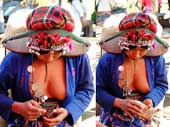 These provinces are in the northern parts of Laos bordering on China and Myanmar. Travel on the main road to these places as well as on the local roads in the provinces can be quite testing. However, the intrepid tourist can be rewarded with some exciting experiences indeed. Up hill and down valleys, cutting through the dense foliage of trees are not experience one can have just about anywhere. These provinces are in the northern parts of Laos bordering on China and Myanmar. Travel on the main road to these places as well as on the local roads in the provinces can be quite testing. However, the intrepid tourist can be rewarded with some exciting experiences indeed. Up hill and down valleys, cutting through the dense foliage of trees are not experience one can have just about anywhere.
BOLOVEN PLATEAU
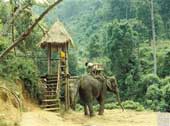 Wich is located on the Boloven Plateau, one of the most scenic spots in Southern Laos. The resort overlooks the Tad Fane Waterfalls, thundering down into a 200-meter deep gorge. Beyond the wsaterfalls stretches the extensive jungle of Dong Hua Sao, one of the 18 National Biodiversity Conservation Areas in the country. The balance of the afternoon and evening are at leisure and dinner at the resort. Overnight at Tadfane Wich is located on the Boloven Plateau, one of the most scenic spots in Southern Laos. The resort overlooks the Tad Fane Waterfalls, thundering down into a 200-meter deep gorge. Beyond the wsaterfalls stretches the extensive jungle of Dong Hua Sao, one of the 18 National Biodiversity Conservation Areas in the country. The balance of the afternoon and evening are at leisure and dinner at the resort. Overnight at Tadfane
HUAY XAI
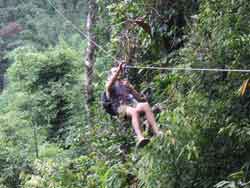 This is situated to the Northwestern part of the country in the Golden Triangle area sharing borders with Thailand and Myanmar. The town is an important trade area and for transportation. It is also famous for precious gem stones and sapphire, rubies and gold mining. This is situated to the Northwestern part of the country in the Golden Triangle area sharing borders with Thailand and Myanmar. The town is an important trade area and for transportation. It is also famous for precious gem stones and sapphire, rubies and gold mining.
HONGSA SAFARI
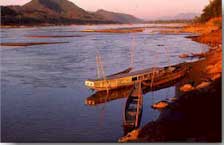 The remoteness and simple lifestyle of hill tribe people are a highlight of Hong Sa although conditions are very basic. After breakfast, we take an elephant ride through the primeval jungle to the Lu hill tribe village where we have a chance to visit local home and enjoy a traditional performance. The remoteness and simple lifestyle of hill tribe people are a highlight of Hong Sa although conditions are very basic. After breakfast, we take an elephant ride through the primeval jungle to the Lu hill tribe village where we have a chance to visit local home and enjoy a traditional performance.
|






 Vientiane the capitals city of Laos is perhaps one of Southeast Asia’s most unique capitals. A quiet and laidback city, there are plenty of interesting French colonial buildings, temples and lively markets located alongside rice fields.
Vientiane the capitals city of Laos is perhaps one of Southeast Asia’s most unique capitals. A quiet and laidback city, there are plenty of interesting French colonial buildings, temples and lively markets located alongside rice fields.  The most important monument in Laos, the Pha That Luang (Great Sacred Stupa) is also found here. Some other interesting places in this city include Wat Pha Kaew, a former royal temple converted into a museum and Wat Si Saket, the city’s oldest temple. Xieng Khuan is 24 kilometers (15 miles) south of Vientiane where an amazing collection of Buddhist and Hindu sculptures can be found in a meadow. Luang Prabang is the oldest town still in existence in Laos.
The most important monument in Laos, the Pha That Luang (Great Sacred Stupa) is also found here. Some other interesting places in this city include Wat Pha Kaew, a former royal temple converted into a museum and Wat Si Saket, the city’s oldest temple. Xieng Khuan is 24 kilometers (15 miles) south of Vientiane where an amazing collection of Buddhist and Hindu sculptures can be found in a meadow. Luang Prabang is the oldest town still in existence in Laos. The only temple in Vientiane to survive the sacking of the city by the Siamese in 1828, Wat Sisaket is the oldest and considered by many to be the most interesting of the Laotian temples. The interior walls of Ho Trai and the main hall feature hundreds of little niches and shelves containing a total of 6,840 Buddha images and Buddhist inscriptions from the 18th century. Over 300 hundred Buddha images varying in size and material reside on the shelves, amongst the silver and ceramic Buddhist images, most of which are from 16th -19th century Vientiane.
The only temple in Vientiane to survive the sacking of the city by the Siamese in 1828, Wat Sisaket is the oldest and considered by many to be the most interesting of the Laotian temples. The interior walls of Ho Trai and the main hall feature hundreds of little niches and shelves containing a total of 6,840 Buddha images and Buddhist inscriptions from the 18th century. Over 300 hundred Buddha images varying in size and material reside on the shelves, amongst the silver and ceramic Buddhist images, most of which are from 16th -19th century Vientiane.  This temple was built in 1565 as a royal chapel and repository for the celebrated statue of the Emerald Buddha, which the Laotians had seized from Northern Thailand in 1551. The statue remained in the temple until 1778, when the Thais invaded and recaptured it, taking it to Bangkok. The temple was destroyed in 1828-1829 during the Thai sacking of Vientiane; rebuilt in 1936; and restored again in 1993. Inspired by a 19th century Bangkok temple style, it is renowned throughout Southeast Asia for its intrinsic value to Buddhist art.
This temple was built in 1565 as a royal chapel and repository for the celebrated statue of the Emerald Buddha, which the Laotians had seized from Northern Thailand in 1551. The statue remained in the temple until 1778, when the Thais invaded and recaptured it, taking it to Bangkok. The temple was destroyed in 1828-1829 during the Thai sacking of Vientiane; rebuilt in 1936; and restored again in 1993. Inspired by a 19th century Bangkok temple style, it is renowned throughout Southeast Asia for its intrinsic value to Buddhist art.  Patuxai (literally Victory Gate or Gate of Triumph), formerly the Anousavary or Anousavari Monument, is situated in the centre of Vientiane. Built between 1962 and 1968, the Laotians built it as a mark of respect for all those who fought in the struggle for independence from the French.
Patuxai (literally Victory Gate or Gate of Triumph), formerly the Anousavary or Anousavari Monument, is situated in the centre of Vientiane. Built between 1962 and 1968, the Laotians built it as a mark of respect for all those who fought in the struggle for independence from the French.  Known as the ‘Black Stupa', many locals believe this mythological structure was once inhabited by a seven-headed dragon (now dormant) that stood to protect the city from the threat of the Siamese. Another tale that does the rounds says that the gold that once graced the surface was taken when the Siamese army ransacked Vientiane back in 1828. Situated in the centre of the city, just past the US embassy, you will find one of Laos' oldest temples.
Known as the ‘Black Stupa', many locals believe this mythological structure was once inhabited by a seven-headed dragon (now dormant) that stood to protect the city from the threat of the Siamese. Another tale that does the rounds says that the gold that once graced the surface was taken when the Siamese army ransacked Vientiane back in 1828. Situated in the centre of the city, just past the US embassy, you will find one of Laos' oldest temples.  24km south of Vientiane, Buddha Park is in a field near the Mekong River. The park, as its name would suggest, is littered with religious sculptures and was built in 1958 by the philosopher Bunleua Sulilat who famously combined Buddhist and Hindu philosophy, mythology and iconography.
24km south of Vientiane, Buddha Park is in a field near the Mekong River. The park, as its name would suggest, is littered with religious sculptures and was built in 1958 by the philosopher Bunleua Sulilat who famously combined Buddhist and Hindu philosophy, mythology and iconography.  Just 16 kilometers outside of Vientiane situated on the banks of the Mekong is the agricultural city of Ban Hom. A day trip might involve taking a wander around the preserved temples before visiting a primary school or watching a weaving demonstration, where the process of fabric making is laid bare. This day is really about getting to grips with authentic Laos culture, with everything from school presentations to observing traditional farming and fishing methods on the itinerary.
Just 16 kilometers outside of Vientiane situated on the banks of the Mekong is the agricultural city of Ban Hom. A day trip might involve taking a wander around the preserved temples before visiting a primary school or watching a weaving demonstration, where the process of fabric making is laid bare. This day is really about getting to grips with authentic Laos culture, with everything from school presentations to observing traditional farming and fishing methods on the itinerary.  Built by the Chinese in the 1990’s, as a gift to the Laos people, the building is not the most attractive Vientiane has known. Occasionally French cinema and Lao classical dance events are held here within the hall, although it is difficult to access information to find out exactly when. Those interested should keep an eye on the Vientiane Times.
Built by the Chinese in the 1990’s, as a gift to the Laos people, the building is not the most attractive Vientiane has known. Occasionally French cinema and Lao classical dance events are held here within the hall, although it is difficult to access information to find out exactly when. Those interested should keep an eye on the Vientiane Times.  This French colonial building, formerly a government office block, is now used to document the struggles and the eventual overthrowing of the French and the subsequent implementation of the communist structure. The Museum Revolution is a two-storey colonial mansion, separated into different sections; each relevant to the country's history. Departments include culture, archaeology, history and politics, with the latter two making up the majority of the display. This is an interesting way to get better acquainted with the history of Laos through the eyes of the country and visitors should keep in mind that the English translations are not that detailed but the photographs and displays are well put together and insightful all the same.
This French colonial building, formerly a government office block, is now used to document the struggles and the eventual overthrowing of the French and the subsequent implementation of the communist structure. The Museum Revolution is a two-storey colonial mansion, separated into different sections; each relevant to the country's history. Departments include culture, archaeology, history and politics, with the latter two making up the majority of the display. This is an interesting way to get better acquainted with the history of Laos through the eyes of the country and visitors should keep in mind that the English translations are not that detailed but the photographs and displays are well put together and insightful all the same.  The capital of Lane Xang, the first Laos kingdom during the reign of Far Ngum. Situated at the confluence of the Mekong and the Nam Khan Rivers, Luang Prabang is a charming little town. Wat Xieng Thong is one of the finest pagodas in Luang Prabang. Built in 1559 by King Setthathirat, it represents the most typical example of the Luang Prabang style. The National Museum (former Royal Palace) contains a collection of 15th to 17th century Buddhist statues including the famous Golden Buddha and the a rare Khmer bronze drum. This small wooden palace was built in the early 20th century by the French in Khmer Style.
The capital of Lane Xang, the first Laos kingdom during the reign of Far Ngum. Situated at the confluence of the Mekong and the Nam Khan Rivers, Luang Prabang is a charming little town. Wat Xieng Thong is one of the finest pagodas in Luang Prabang. Built in 1559 by King Setthathirat, it represents the most typical example of the Luang Prabang style. The National Museum (former Royal Palace) contains a collection of 15th to 17th century Buddhist statues including the famous Golden Buddha and the a rare Khmer bronze drum. This small wooden palace was built in the early 20th century by the French in Khmer Style. Xieng Khuang is a high green mountainous province offering a beneficial climate but a decidedly unhealthy environment, with large quantities of UXO [unexploded ordnance, aka bombs or bomblets] still lying around in the undergrowth - solid proof of allegations that the CIA and US Air Force conspired in a secret war against the North Vietnamese and Pathet Lao forces in the late 60's, using saturation bombing as their main tool of attack. In the process the USAF totally obliterated many towns and villages, forcing survivors to live in the area's caves.
Xieng Khuang is a high green mountainous province offering a beneficial climate but a decidedly unhealthy environment, with large quantities of UXO [unexploded ordnance, aka bombs or bomblets] still lying around in the undergrowth - solid proof of allegations that the CIA and US Air Force conspired in a secret war against the North Vietnamese and Pathet Lao forces in the late 60's, using saturation bombing as their main tool of attack. In the process the USAF totally obliterated many towns and villages, forcing survivors to live in the area's caves. A province to the south where Wat Phu, a temple built in Khmer Architecture is found. Wat Phu is believed to be at least four centuries older than the Angkor Wat of Cambodia.
A province to the south where Wat Phu, a temple built in Khmer Architecture is found. Wat Phu is believed to be at least four centuries older than the Angkor Wat of Cambodia. Vang Vieng - halfway between Vientiane and Luang Prabang - is a town almost totally geared up to the lowest common denominator of back packers and is consequently despised by aficionados of real, tranquil, rural Laos. Rowdy bars line up along the main street, each showing a different episode of 'Friends', often simultaneously and without earshot of the others, while young travelers stagger back to neo-monstrosity concrete guest houses after way too many beers.However, it is still possible to avoid the curse of modernism and enjoy the magnificent scenery and activities available near and around Vang Vieng. Just turn a blind eye to the main street.There's superb caving, trekking, climbing, biking, kayaking, tubing...you name it, it's around here in Vang Vieng, action central, Laos.
Vang Vieng - halfway between Vientiane and Luang Prabang - is a town almost totally geared up to the lowest common denominator of back packers and is consequently despised by aficionados of real, tranquil, rural Laos. Rowdy bars line up along the main street, each showing a different episode of 'Friends', often simultaneously and without earshot of the others, while young travelers stagger back to neo-monstrosity concrete guest houses after way too many beers.However, it is still possible to avoid the curse of modernism and enjoy the magnificent scenery and activities available near and around Vang Vieng. Just turn a blind eye to the main street.There's superb caving, trekking, climbing, biking, kayaking, tubing...you name it, it's around here in Vang Vieng, action central, Laos. These provinces are in the northern parts of Laos bordering on China and Myanmar. Travel on the main road to these places as well as on the local roads in the provinces can be quite testing. However, the intrepid tourist can be rewarded with some exciting experiences indeed. Up hill and down valleys, cutting through the dense foliage of trees are not experience one can have just about anywhere.
These provinces are in the northern parts of Laos bordering on China and Myanmar. Travel on the main road to these places as well as on the local roads in the provinces can be quite testing. However, the intrepid tourist can be rewarded with some exciting experiences indeed. Up hill and down valleys, cutting through the dense foliage of trees are not experience one can have just about anywhere. Wich is located on the Boloven Plateau, one of the most scenic spots in Southern Laos. The resort overlooks the Tad Fane Waterfalls, thundering down into a 200-meter deep gorge. Beyond the wsaterfalls stretches the extensive jungle of Dong Hua Sao, one of the 18 National Biodiversity Conservation Areas in the country. The balance of the afternoon and evening are at leisure and dinner at the resort. Overnight at Tadfane
Wich is located on the Boloven Plateau, one of the most scenic spots in Southern Laos. The resort overlooks the Tad Fane Waterfalls, thundering down into a 200-meter deep gorge. Beyond the wsaterfalls stretches the extensive jungle of Dong Hua Sao, one of the 18 National Biodiversity Conservation Areas in the country. The balance of the afternoon and evening are at leisure and dinner at the resort. Overnight at Tadfane This is situated to the Northwestern part of the country in the Golden Triangle area sharing borders with Thailand and Myanmar. The town is an important trade area and for transportation. It is also famous for precious gem stones and sapphire, rubies and gold mining.
This is situated to the Northwestern part of the country in the Golden Triangle area sharing borders with Thailand and Myanmar. The town is an important trade area and for transportation. It is also famous for precious gem stones and sapphire, rubies and gold mining. The remoteness and simple lifestyle of hill tribe people are a highlight of Hong Sa although conditions are very basic. After breakfast, we take an elephant ride through the primeval jungle to the Lu hill tribe village where we have a chance to visit local home and enjoy a traditional performance.
The remoteness and simple lifestyle of hill tribe people are a highlight of Hong Sa although conditions are very basic. After breakfast, we take an elephant ride through the primeval jungle to the Lu hill tribe village where we have a chance to visit local home and enjoy a traditional performance.